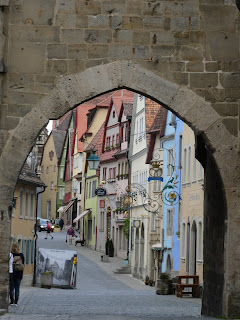Leaving Rothenburg I was distracted taking photos, thus taking a lot longer than I should to have left town! I got as far as the wonderful swimming pool and was trying to work out what I was meant to do in terms of crossing the road, or not, at this point. A couple happened to be walking past and asked what I was looking for, and informed me that I needn’t look for the Via Romea signs as there weren’t any – I was to follow the M D signs. I could see no relation to my signs but decided to take his word for it, following them as we wound our way downhill to the River Tauber, with me mentally trying to figure out what M D might mean. I nearly shouted out to the man to point out the one Via Romea sign I saw for quite a few kilometres, but refrained because it was here that my puzzling was solved – M D stands for Main Donau (Cycle path). Mind you, it was another kilometre before my brain twigged that Main didn’t refer to the Donau path as the primary path but it was referring to the River Main (and of course the River Donau – Danube in English).
The path wandered through the country side, sometimes lovely soft dirt or grassy tracks, but very often, initially, asphalt cycle paths. I went past or through pretty little villages, stopping and chatting to women in the village of Bockenfeld. They were very interested in what I was doing and enlightened me that there was no bakery in town – I didn’t really need it, but it would have been nice to sit down and have a coffee. This village had a steep climb out of it and I was rewarded of good views, looking back, of Rothenburg. After crossing the motorway, I walked along the ridge before then dropping down into the village of Faulenberg which had a very convenient table and seat under a shady tree. I lingered there for a while trying to figure out what a man was doing with a machine. It was a quiet machine, but looked like a mower. I THINK he was sweeping the road with it, so it was probably a vacuum cleaner – collecting all the petals that had fallen. He diligently worked on the path outside what I assume was his house and the church the whole time I sat there, exchanging a wave with me at one point.
From there it was a climb, through a forest, up to the village of Schillingsfurst. I had timed it wrong for this town. There was a medieval fair on which meant that I had no option in the accommodation department – except expensive! Mind you my deluxe single room was very nice! I didn’t go to the fair, but saw plenty of the lads and lasses all dressed up.
The next stage was to Feuchtwangen and I set off after breakfast with a stiff cool breeze blowing. I had come downhill to my Gasthouse, and unfortunately that meant I had to go back uphill. It was a lovely days walk through forest and across fields. The cool breeze soon stopped and so I was very glad to be walking in the forest. The trees now have their leaves – still a bright spring green, and their dappled light, combined with the bird song I hear as I walk makes it a great joy to be able to do this. I have been hearing since day 1 the tapping of a woodpecker, and today I heard a cuckoo. I can’t name any of the other birds though I am afraid.
In contrast to walking in the forest, the open country side was very hot, and so I was very glad to find a Gasthouse open and serving lunch. I was more interested in a cold drink than food, but partook of both, and I must say it is quite nice to have a tasty lunch for a change.
Feuchtwangen is a delightful town. After settling into my zimmer (room) I headed out to explore. There are two churches here, one of them being part of a former Benedictine Monastery. Both churches are next door to each other very near the Markt, which is surrounded by brightly coloured old buildings. Being such a nice spring day the place was buzzing.
The helpful couple who directed me on the way.
The views on the part of the way.
Looking back at Rthenburg in the distance and the yellow church of Bockenfeld in the foreground.
Heading to the Medieval Fair at Schillingsfurst
Leaving my Gasthaus (above right) i had a view of the Schloss in the distance,
Departing Schillingsfurst, and the views of the chrches and the Schloss on top of the hill.
The path trhough the forest and the view of it (right)
After descending through the forest the path came out at Kloster Sulz
Feuchtwangen is a delightful town. After settling into my zimmer (room) I headed out to explore. There are two churches here, one of them being part of a former Benedictine Monastery. Both churches are next door to each other very near the Markt, which is surrounded by brightly coloured old buildings. Being such a nice spring day the place was buzzing.
Stiftkirche - Town Church, Feuchtwangen, and St Johannis, Pfarrkirche
Feuchtwangen










































































